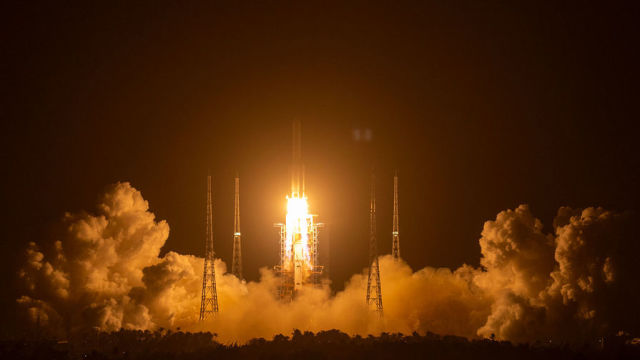China plans to extract gigawatts of energy from space
Chinese scientists want to receive megawatts and gigawatts of energy from space. To do this, they plan to put a huge power plant into geostationary orbit.
China intends to become the first country to build a solar power plant in near-Earth orbit, which will transfer the collected energy to the Earth. The Changzheng-9 superheavy launch vehicle currently being designed will be used for the construction of the giant structure.
It was decided to build the station in a geostationary orbit, at an altitude of 35,786 kilometers, where it will be able to constantly stay stationary above the selected point of the Earth, said Lun Lehao, chief designer of the Chinese Changzheng-9 series rockets at a presentation held in Hong Kong, SpaceNews reports.
The project provides for the construction of large solar panels in orbit, the advantage of such a power plant will be the possibility of almost constant production of solar energy, regardless of weather conditions.
According to Loon, the project should begin with a small experiment on energy transfer in 2022, and by 2030 it is planned to put a full-fledged megawatt-class power plant into orbit. Chinese scientists want to build a gigawatt-class commercial station in orbit by 2050. According to their calculations, this will require more than a hundred launches of the Changzheng-9 superheavy rocket, during which about 10 thousand tons of structures will be delivered to orbit for the assembly of the structure.
It is expected that the total area of the solar power plant will be one square kilometer.
Lun and Qi Fazhen, another high-ranking designer of Chinese space technology, noted that the construction of the station will be fraught with a number of difficulties. The scientists will face the tasks of making the station economically viable, reducing the cost of construction, solving the issues of efficiency and safety of energy transmission to Earth.
Similar ideas have been repeatedly proposed by various countries, including Japan and the United States, but they have not yet reached practical implementation. The project of an orbital power plant was mentioned among the Chinese space plans, in 2019, the construction of an experimental base for testing methods of wireless energy transmission over a distance was started in the city of Chongqing.
The Changzheng-9 superheavy rocket, which is planned to launch elements of the station into space, received approval from the Chinese government last spring after several years of development.
It is planned that the improved version of the rocket will be able to put up to 150 tons into low-Earth orbit, and from 50 to 53 tons on a flight path to the Moon.
This summer, the world's attention is focused on Chinese cosmonautics due to the construction of a long-term orbital station. Ten days ago, from the Jiuquan cosmodrome on the border of the Chinese province of Gansu and the Inner Mongolia Autonomous Region, a launch vehicle "Changzheng-2F" ("Great Hike-2F") was launched with the Shenzhou - 12 spacecraft, on board of which Chinese taikonauts went into Earth orbit for the first time in five years.
Three crew members, 56-year-old Nie Haisheng, 54-year-old Liu Boming and 45-year-old Tang Hongbo will become the first taikonauts to master the Chinese space station being created in Earth orbit.
It is known that the service life of the Tianhe module module is at least ten years. The launch of the first crew of the national space station is very important for China, where the 100th anniversary of the Communist Party will be celebrated on July 1.
China periodically carries out manned space missions every few years, the first of them (Shenzhou-1) in a test mode (without people on board) was carried out in November 1999. China first sent an astronaut to near-Earth space in October 2003 (Yang Liwei). The current manned launch of Shenzhou-12 is the first since October 2016, it will be the longest continuous stay (three months) of Chinese astronauts in orbit.

